Socket Mobile BTM-1 Bluetooth Module User Manual SerialModule
Socket Mobile, Inc. Bluetooth Module SerialModule
Installers technical manual

Bluetooth Module Specification
Raw Serial Modules
Revision 0.7
April 4, 2003

Bluetooth Raw Serial Module Technical Specification
Apr. 4, 03 Copyright © 2003, Socket Communications, Inc. Page i
Document#: 6410-00195 A Revision 0.7
Reproduction of the contents of this manual without the permission of Socket Communications,
Inc. is expressly prohibited.
Please be aware that the products described in this manual may change without notice.
This manual has been prepared with the greatest care regarding its contents. However, in the
event that it contains omissions, errors or any other misinformation, please feel free to direct
comments to:
Socket Communications, Inc.
37400 Central Court
Newark, CA 94560
You are also welcome to call Socket Communications Inc. at (510) 744-2700, or you may FAX
inquiries to (510) 744-2727.
Other than the above, Socket Communications, Inc. can assume no responsibility for anything
resulting from the application of information contained in this manual.

Bluetooth Raw Serial Module Technical Specification
Apr. 4, 03 Copyright © 2003, Socket Communications, Inc. Page ii
Document#: 6410-00195 A Revision 0.7
Regulatory Compliance
The Socket Bluetooth module is designed to be compliant with the rules and regulations in
locations where they are sold and will be labeled as required. This product is type approved —
users are not required to obtain license or authorization before using.
Radio Frequency Interference Requirements
This device complies with part 15 of the FCC rules. Operation is subject to the following
conditions: (1) This device may not cause harmful interference, and (2) this device must accept
any interference received, including interference that may cause undesired operation.
This equipment is also ETS 300 328, ETS 300 826 and C-TICK compliant. These limits are
designed to provide reasonable protection against harmful interference when the equipment is
operated in a commercial environment.
This equipment generates, uses, and can radiate radio frequency energy and, if not installed and
used in accordance with the instruction manual, may cause harmful interference to radio
communications. Operation of this equipment in a residential area is likely to cause harmful
interference, in which case the user will be required to correct the interference at his or her own
expense.
This equipment generates and radiates radio-frequency energy. To comply with FCC RF
exposure compliance requirements, the following antenna installation and device operating
configurations must be satisfied: (1) Users are not permitted to make changes or modify the
system in any way, and (2) connecting external antennas to the card is prohibited. Changes or
modifications not expressly approved by the party responsible for compliance could void the
user’s authority to operate the equipment.
If this equipment does cause harmful interference to radio or television reception, which can be
determined by turning the equipment off and on, the user may try to correct the interference by
one or more of the following measures:
Reorient or relocate the receiving antenna of the radio or television.
Increase the distance separating the equipment and the receiver.
Connect the equipment to an outlet on a different branch circuit than that of the receiver.
Consult the dealer or an experienced radio/TV technician for help.
The user may find the following booklet helpful: How to Identify and Resolve Radio-TV
Interference Problems. This booklet is available from the U.S. Government Printing Office,
Washington, D.C. 20402.

Bluetooth Raw Serial Module Technical Specification
Apr. 4, 03 Copyright © 2003, Socket Communications, Inc. Page iii
Document#: 6410-00195 A Revision 0.7
U.S. Regulatory Wireless Notice
This product emits radio frequency energy, but the radiated output power of this device is far
below the FCC radio frequency exposure limits. Nevertheless, the device should be used in such
a manner that the potential for human contact with the antenna during normal operation is
minimized.
Radio Frequency Interference Requirements – Canada
This Class B digital apparatus meets the requirements of the Canadian Interference-Causing
Equipment Regulations. Cet appareil numérique de la Classe B respecte toutes les exigencies du
Reglement sur le Matériel Brouilleur du Canada.
Canadian Regulatory Wireless Notice
Operation is subject to the following two conditions: (1) this device may not cause interference,
and (2) this device must accept any interference, including interference that may cause undesired
operation of the device.
To prevent radio interference to the licensed service, this device is intended to be operated
indoors and away from windows to provide maximum shielding. Equipment (or its transmit
antenna) that is installed outdoors is subject to licensing.
The term “IC:” before the certification/registration number only signifies that the Industry
Canada technical specifications were met.
CE Marking & European Union Compliance
Products intended for sale within the European Union are marked with a CEMark which
indicates compliance to applicable Directives and European Normes (EN), as follows.
Amendments to these Directives or ENs are included: Normes (EN), as follows:
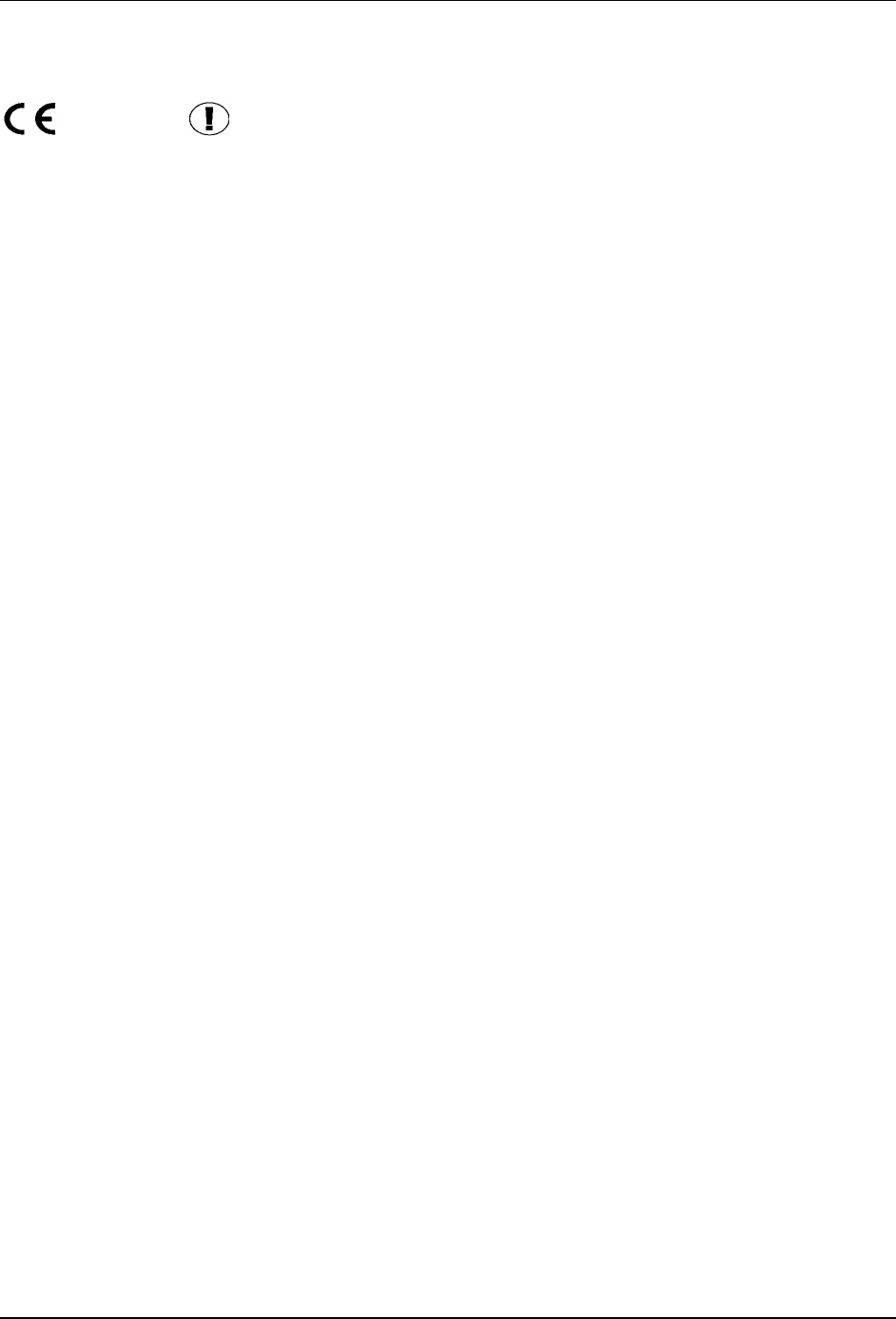
Bluetooth Raw Serial Module Technical Specification
Apr. 4, 03 Copyright © 2003, Socket Communications, Inc. Page iv
Document#: 6410-00195 A Revision 0.7
European Union Notice
0682
Products bearing the CE marking comply with the R&TTE Directive (1999/5/EC), EMC
Directive (89/336/EEC), and the Low Voltage Directive (73/23/EEC) issued by the Commission
of the European Community.
Compliance with these directives implies conformity to the following European Norms (in
parentheses are the equivalent international standards and regulations):
EN 55022 (CISPR 22)—Electromagnetic Interference
EN 55024 (IEC61000-4-2, 3, 4, 5, 6, 8, 11)—Electromagnetic Immunity
EN61000-3-2 (IEC61000-3-2)—Power Line Harmonics
EN61000-3-3 (IEC61000-3-3)—Power Line Flicker
EN 60950 (IEC 60950)—Product Safety
EN 300 328—Technical requirements for radio equipment
ETS 300 826 or EN 301 489-17—General EMC requirements for radio equipment
This product may be used in all EU and EFTA countries.
Applicable Standards:
EN 55 022 – Limits and Methods of Measurement of Radio Interference Characteristics of
Information Technology Equipment.
EN 50 082-1 – Electromagnetic Compatibility – General Immunity Standard, Part 1:
Residential, Commercial, Light Industry.
IEC 801.2 – Electromagnetic Compatibility for Industrial Process Measurement and
Control Equipment, Part 2: Electrostatic Discharge Requirements.
IEC 801.3 – Electromagnetic Compatibility for Industrial Process Measurement and
Control Equipment, Part 3: Radiated Electromagnetic Field Requirements.
IEC 801.4 - Electromagnetic Compatibility for Industrial Process Measurement and
Control Equipment, Part 4: Electrical Fast Transients Requirements.
EN 60 950 + Amd 1 + Amd 2 – Safety of Information Technology Equipment Including
Business Equipment.
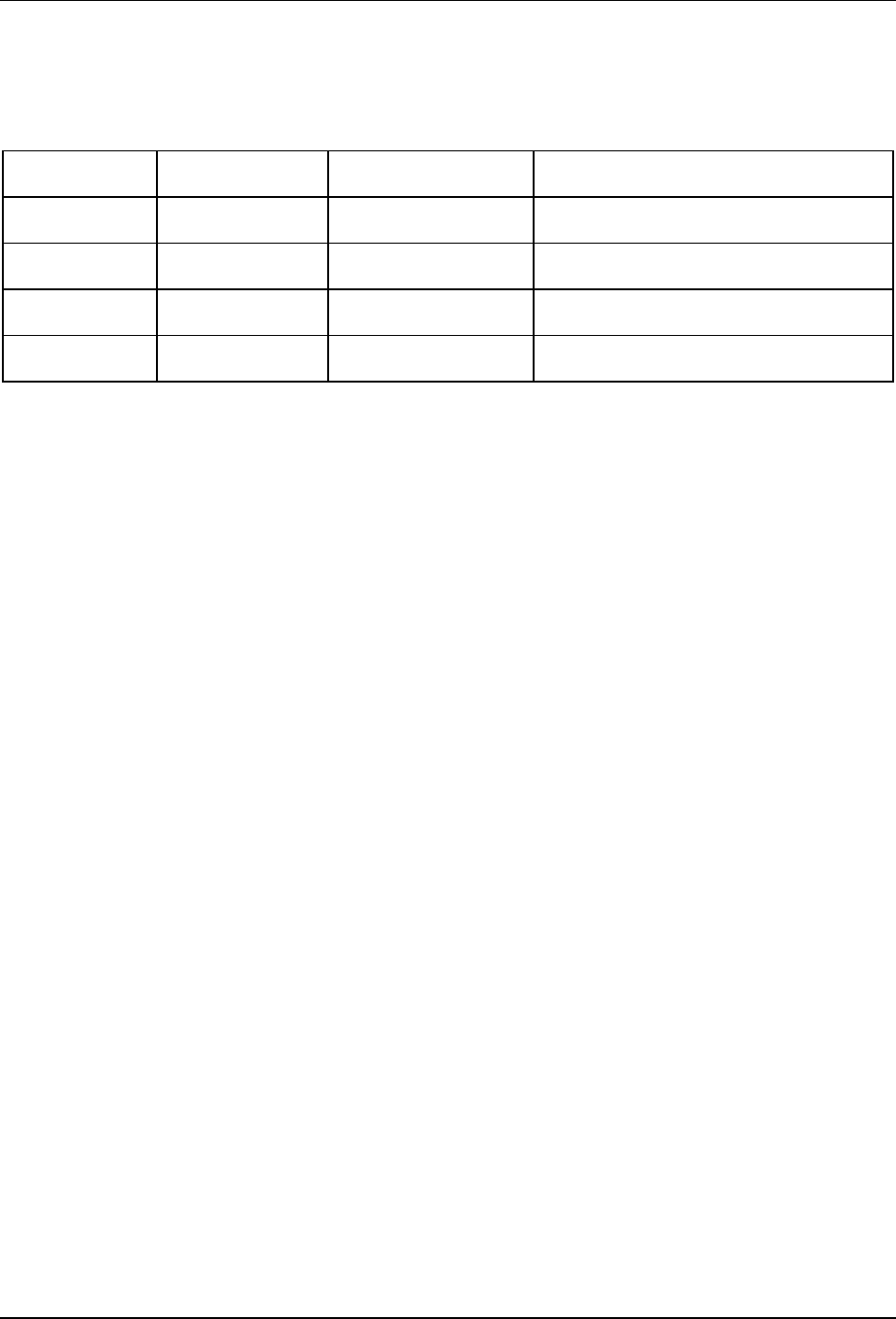
Bluetooth Raw Serial Module Technical Specification
Apr. 4, 03 Copyright © 2003, Socket Communications, Inc. Page v
Document#: 6410-00195 A Revision 0.7
Revision Table
Revision Date Who Comments
0.1 Feb 28, 2003 Charles Ader Create Spec
0.2 Mar 21, 2003 Charles Ader Add ref to Blutooth documents
0.6 Mar 28, 2003 Charles Ader Harmonize with dongle spec
0.7 Apr 1, 2003 Charles Ader Correct description of PIO3

Bluetooth Raw Serial Module Technical Specification
Apr. 4, 03 Copyright © 2003, Socket Communications, Inc. Page vi
Document#: 6410-00195 A Revision 0.7
Table of Contents
1. Introduction........................................................................................................................... 1
1.1. Product definition................................................................................................................ 1
1.2. Feature List ......................................................................................................................... 1
1.3. Notation............................................................................................................................... 1
2. Physical/Environmental ....................................................................................................... 2
3. Electrical Requirements ....................................................................................................... 3
3.1. Average Power Consumption ............................................................................................. 4
3.2. Peak Current Consumption................................................................................................. 4
4. Hardware Interface ..............................................................................................................5
4.1. Module Pin Assignments .................................................................................................... 5
5. Hardware Interface Protocol............................................................................................... 6
5.1. Initialization status.............................................................................................................. 6
5.2. Connection enable............................................................................................................... 6
5.3. Connection Status ............................................................................................................... 6
5.4. RTS Flow Control Management......................................................................................... 6
5.5. CTS Flow Control Management......................................................................................... 7
6. Command............................................................................................................................... 8
6.1. User configuration methods................................................................................................ 9
6.2. Operating Modes................................................................................................................. 9
6.3. Command and Control Modes............................................................................................ 9
6.3.1. Query Mode Commands ....................................................................................................... 10
6.3.2. Set Local Bluetooth Device Name ........................................................................................ 11
6.3.3. Set Serial Line Parameters .................................................................................................... 11
6.3.4. Set Class of Device/Service field .......................................................................................... 12
6.3.5. Set Service Name .................................................................................................................. 12
6.3.6. Set Sniff Parameters.............................................................................................................. 12
6.3.7. Connectable on/off: "ON" or "OFF".................................................................................... 13
6.3.8. Specify Page Scan Timing ....................................................................................................13
6.3.9. Enable Discoverable.............................................................................................................. 13
6.3.10. Specify Inquiry Scan Timing ................................................................................................13
6.3.11. Set Encryption/Authentication: "PIN CODE" .....................................................................14
6.3.12. Set Connectable Device Bluetooth Address.......................................................................... 14
6.3.13. Set CONNECT / DICSONNECT event enable .................................................................... 15
6.3.14. Disable Encryption/Authentication....................................................................................... 15
6.3.15. Read module Version............................................................................................................ 15
6.3.16. Read local device address ..................................................................................................... 16
6.3.17. Read local device role ........................................................................................................... 16
6.4. EVENTS ........................................................................................................................... 16
6.4.1. Link Connect......................................................................................................................... 16

Bluetooth Raw Serial Module Technical Specification
Apr. 4, 03 Copyright © 2003, Socket Communications, Inc. Page vii
Document#: 6410-00195 A Revision 0.7
6.4.2. Link Disconnect .................................................................................................................... 17

Bluetooth Raw Serial Module Technical Specification
Apr. 4, 03 Copyright © 2003, Socket Communications, Inc. Page viii
Document#: 6410-00195 A Revision 0.7
List of Tables
Table 1: Ratings ...............................................................................................................................2
Table 2: Operating Conditions.........................................................................................................3
Table 3: Input/Output Terminal Characteristics ..............................................................................3
Table 4: Average Power Consumption............................................................................................4
Table 5: Peak Power Consumption..................................................................................................4
Table 6: Module Pin Assignment ....................................................................................................5

Bluetooth Raw Serial Module Technical Specification
Apr. 4, 03 Copyright © 2003, Socket Communications, Inc. Page 1
Document#: 6410-00195 A Revision 0.7
1. Introduction
1.1. Product definition
In the Module product line there will be 2 versions of products:
Raw Serial Module – External Power - Provide a basic Serial Cable replacement function
with some user accessible command modes
Bluetooth HCI module – Provide Host Command Interface for Bluetooth stack implemented
on an external local host processor.
This document will describe only the Raw Serial Module.
1.2. Feature List
· Very small size
· Low Cost
· Socket Cost : External Power Version: $30-35 range
· Industrial Application target design
· Initially offered in Class 2 BT Radio but will offer Class 1 later
· External Power device will run off 3.3 external power
· Firmware and module code upgradeable in the field via programming interface
· Security and bonding supported
· Low power Bluetooth modes: Sniff, Park and Hold
· Not suitable for Baud Rates below 9600 Baud
1.3. Notation
Numbers are in decimal except:
· Numbers with an “h” suffix are in hexadecimal.
· Numbers with a “0x” prefix are in hexadecimal.
· Numbers with a “b” suffix are in binary.
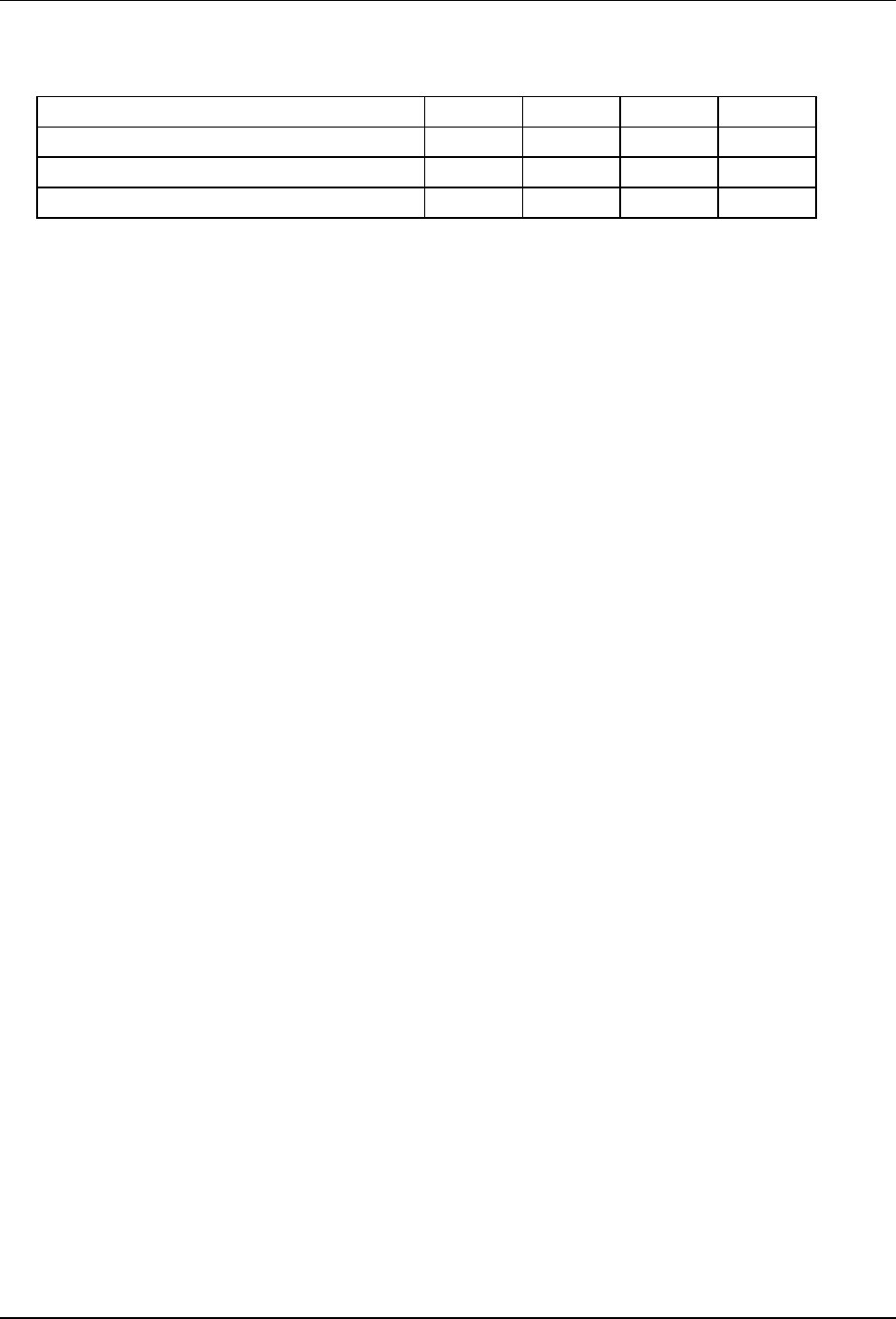
Bluetooth Raw Serial Module Technical Specification
Apr. 4, 03 Copyright © 2003, Socket Communications, Inc. Page 2
Document#: 6410-00195 A Revision 0.7
2. Physical/Environmental
Description Min Max Unit
Operating Temperature -20 +85 deg.C
Storage Temperature -40 +85 deg.C
Supply Voltage VDD -0.4 3.6 V
Table 1: Ratings
Humidity: 5% to 95% (non-condensing)
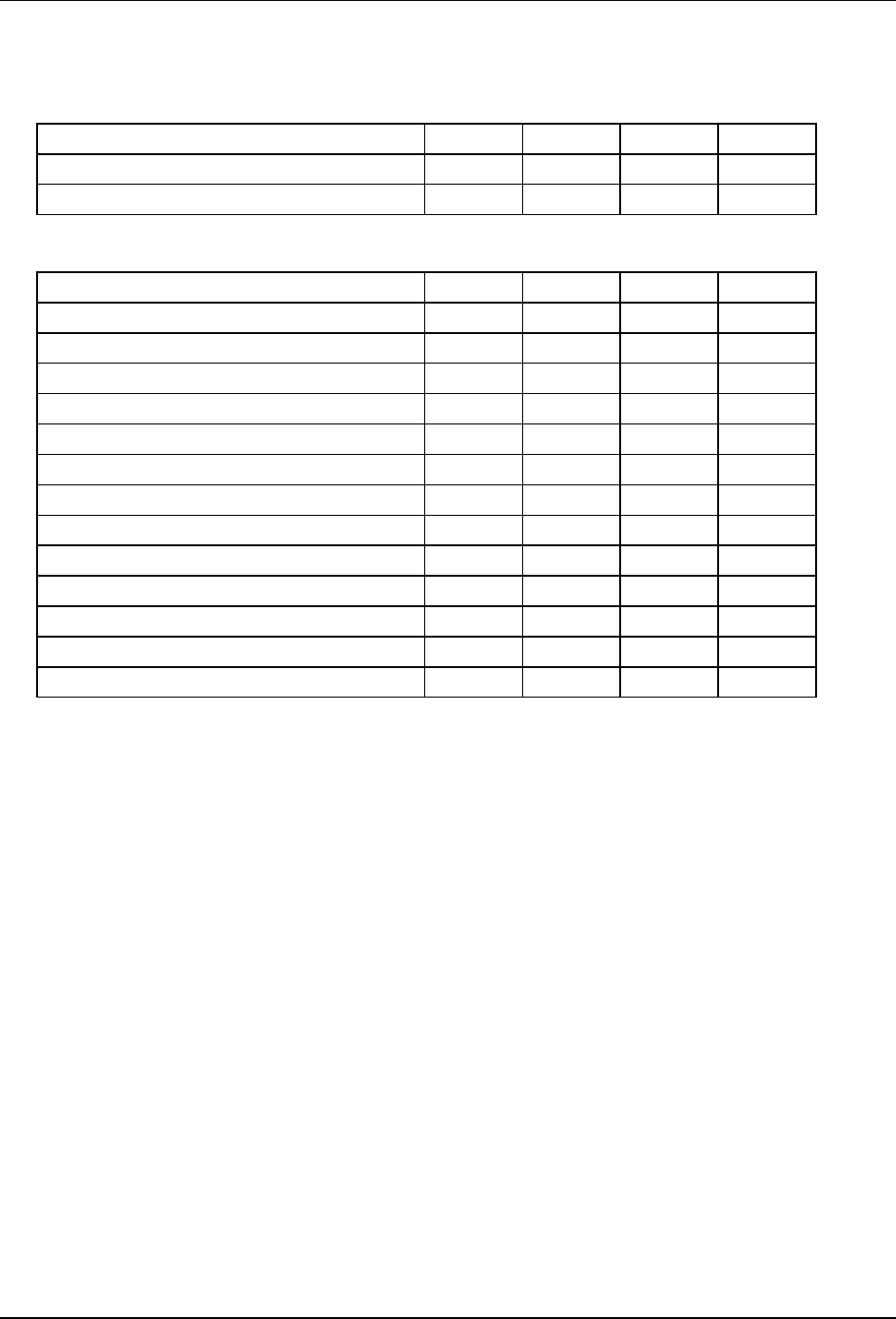
Bluetooth Raw Serial Module Technical Specification
Apr. 4, 03 Copyright © 2003, Socket Communications, Inc. Page 3
Document#: 6410-00195 A Revision 0.7
3. Electrical Requirements
Description Min Typ Max Unit
Operating Temperature -20 +25 +85 deg.C
Supply Voltage, VDD 2.7 3.0 3.6 V
Table 2: Operating Conditions
Min Typ Max Unit
Input Voltage
VIL input logic level low (VDD=3.0V) -0.4 +0.8 V
VIH input logic level high 0.7VDD VDD+0.4 V
Output voltage
VOL output logic level low, (lO = 4.0mA), VDD=3.0V - - 0.2 V
VOH output logic level high, (lO = -4.0mA), DD=3.0V VDD-0.2 - - V
Input and Tristate Current with:
Strong pull-up -100 -20 -10 µA
Strong pull-down +10 +20 +100 µA
Weak pull-up -5 -1 0 µA
Weak pull-down 0 +1 +5 µA
I/O pad leakage current -1 0 +1 µA
Ci Input Capacitance 2.5 - 10 pF
Table 3: Input/Output Terminal Characteristics
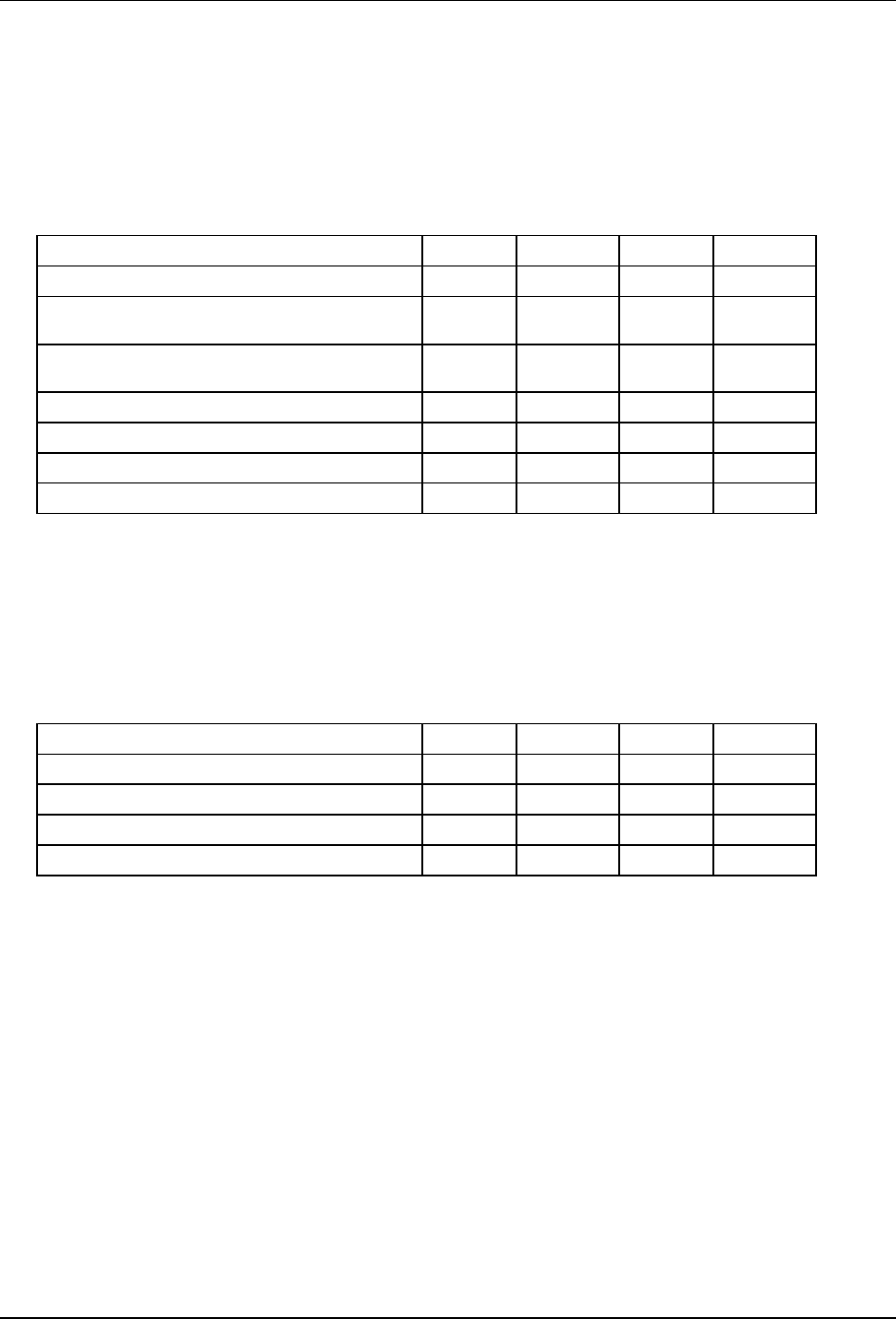
Bluetooth Raw Serial Module Technical Specification
Apr. 4, 03 Copyright © 2003, Socket Communications, Inc. Page 4
Document#: 6410-00195 A Revision 0.7
3.1. Average Power Consumption
Maximum current draw and power consumption of the Raw Serial Module is shown in the
following table. Expect ±10% variation over temperature.
Tambient= +20º C
Mode Typ Units
ACL data transfer, 115.2kbps, UART (Master) 15.0 mA
ACL connection Sniff Mode, 40ms interval, 38.4kpbs
UART
6 mA
ACL connection Sniff Mode, 1.28s interval, 38.4kpbs
UART
4 mA
Parked Slave, 1.28s beacon interval, 38.4kpbs UART 4 mA
ACL data transfer 720kbps USB (Slave) 53.0 mA
ACL data transfer 720kbps USB (Master) 53.0 mA
Standby mode (Connected to host no RF activity) 50 µA
Table 4: Average Power Consumption
3.2. Peak Current Consumption
Tambient= +20º C
Mode Typ Max Units
Deep Sleep Mode 20.0 50 µA
Peak current during TX burst (+4 dBm) 70.0 80 mA
Peak current during TX burst (0 dBm) 60.0 70 mA
Peak current during RX burst (-85 dBm) 50.0 70 mA
Table 5: Peak Power Consumption
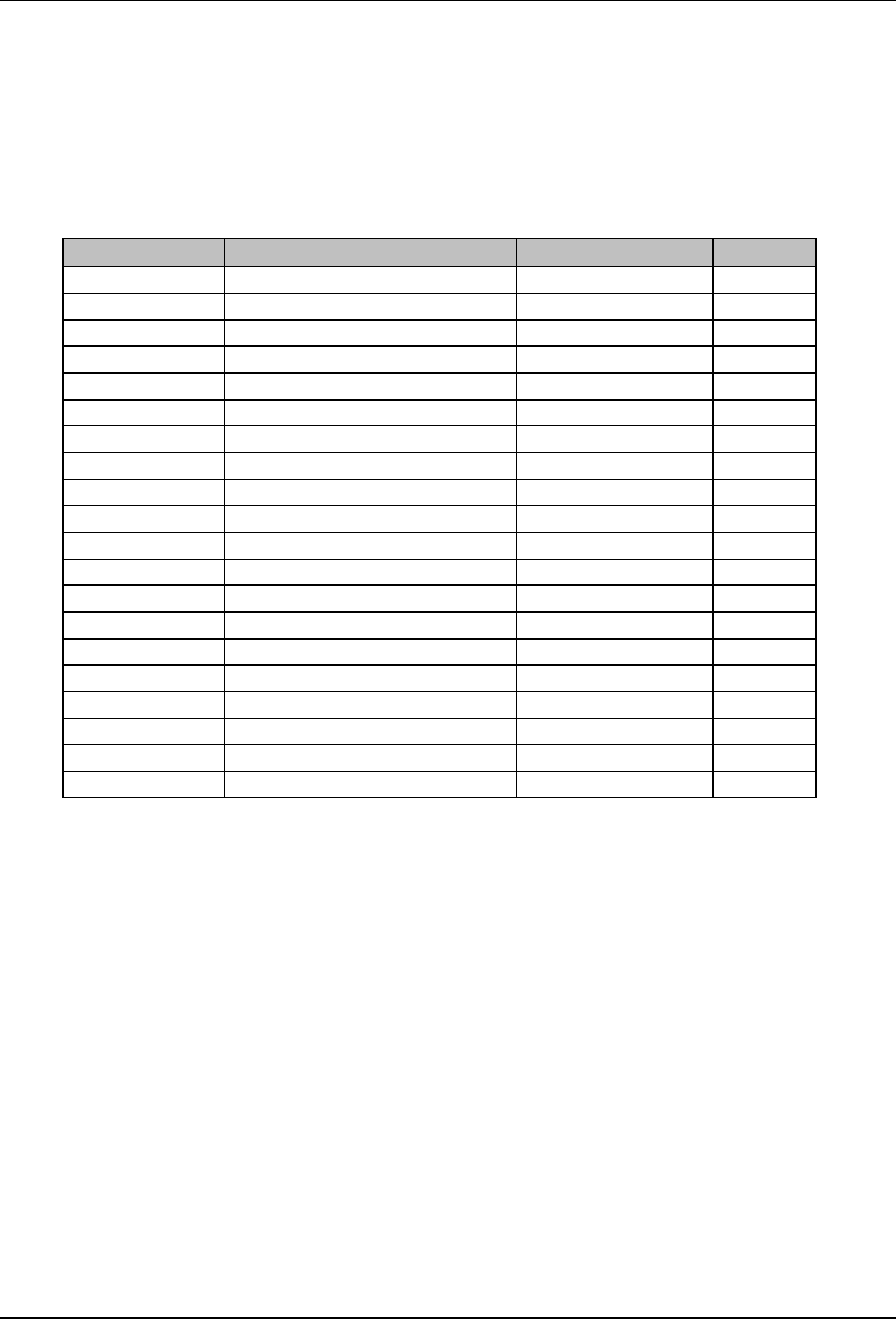
Bluetooth Raw Serial Module Technical Specification
Apr. 4, 03 Copyright © 2003, Socket Communications, Inc. Page 5
Document#: 6410-00195 A Revision 0.7
4. Hardware Interface
4.1. Module Pin Assignments
Signal Name Function Direction Pin #
GROUND Power supply return 1
PCM_OUT Serial data from audio CODEC IN 2
PCM_IN Serial data to audio CODEC OUT 3
PIO_1 Generic I/O local host OUT 4
PIO_4 Generic I/O local host RS232 (DTR) OUT 5
UART_RXD Serial data from local host RS232 (RXD) IN 6
UART_TXD Serial data to local host RS232 (TXD) OUT 7
RESET Reset module when HIGH IN 8
PIO_3 Generic I/O local host RS232 (DSR) IN 9
SPI_CSB SPI chip select IN 10
GROUND Power supply return 11
UART_RTS Local host must not send when HIGH OUT 12
SPI_CLK SPI Clock IN 13
UART_CTS Module must not send when HIGH IN 14
PCM_SYNC Audio CODEC signal OUT 15
PIO_2 Generic I/O local host RS232 (DCD) IN 16
SPI_MOSI SPI master out slave in IN 17
PCM_CLK Audio CODEC signal OUT 18
SPI_MISO SPI master in slave out OUT 19
VCC_3.3V Power supply 20
Table 6: Module Pin Assignment

Bluetooth Raw Serial Module Technical Specification
Apr. 4, 03 Copyright © 2003, Socket Communications, Inc. Page 6
Document#: 6410-00195 A Revision 0.7
5. Hardware Interface Protocol
5.1. Initialization status
Hardware line Pin 4 (PIO_1) is used as a status indicator. This line is LOW (zero) indicates
that the module has not completed initialization. This line HIGH (one) indicates that the
module has completed its initialization and is ready to accept commands or Bluetooth
connections.
5.2. Connection enable
Hardware line Pin 9 (PIO_3), can be used to enable the module’s connectability and
discoverability.
If the module is configured in software to be a slave device, when this line is high the module
is not discoverable or connectable, regardless of the software settings. When this line is low
the module can be discoverable and connectable, depending on the software settings. If this
line is changed from low to high, any existing connections are dropped and the module will
not be discoverable or connectable.
If the module is configured in software to be a master device, when this line is high the
module will not attempt to connect to its ‘slave’ device (if it has one). When this line is low
the module will attempt to connect to its slave device.
5.3. Connection Status
Hardware line Pin 5 (PIO_4) is used by the local host to determine the modules current
connection state. When this pin is low, there is an active connection. When this pin is high,
there is no connection currently active. This pin can be used by the host to determine when
the module is in BT Link Active state or BT Link Inactive state.
5.4. RTS Flow Control Management
Hardware line Pin 12, RTS is used by the module to hold of data or command transmissions
from the host. When RTS is LOW, data or commands can be sent to the module, when RTS
is HIGH, data or commands should not be sent to the module.
When the module is starting up after power up, RTS may go inactive for a short time. It will
return to active when ready to receive control commands or data.

Bluetooth Raw Serial Module Technical Specification
Apr. 4, 03 Copyright © 2003, Socket Communications, Inc. Page 7
Document#: 6410-00195 A Revision 0.7
5.5. CTS Flow Control Management
Hardware line Pin 14, CTS is used to control data flow from the module to the local host.
When this line is low the module will not send data to the local host. When this line is high
the module will send any available data to the local host.

Bluetooth Raw Serial Module Technical Specification
Apr. 4, 03 Copyright © 2003, Socket Communications, Inc. Page 8
Document#: 6410-00195 A Revision 0.7
6. Command
All printable characters can be entered directly via the keyboard. Any non-printable characters
are entered in binary data format.
Binary data format:
Any non seven-bit ASCII data to be transmitted to the module will be encoded in the internet
'percent' notation. Any hex byte to be transmitted is preceded by the '%' sign and encoded in hex
ASCII. Thus, to send the value 0xF5, the following bytes would be transmitted: "%F5". To
send the '%' character is always transmitted as "%25". Thus, a Bluetooth address 'could' be
transmitted as "%00%E0%03%45%F4%6D".
Generic format:
<command character><command type><command payload><CR>
<command character> is one character from the set: [A-Z]
<command type> is one character for the set: [0-9]
<command payload> is variable in length.
<CR> is the command terminator.
The <command payload> is formed from printable ASCII characters from the code range 0x20
to 0x7E. Codes outside of this range are escaped using the percent (%) character followed by two
hexadecimal digits.
The percent character is always represented by the three characters: %25
The command terminator is character code 0x13 (carriage return), or character code 0x10 (line
feed), or character codes 0x13, 0x10 (carriage return, line feed)
An example command to set the friendly name to "Len's 100% serial module":
F0Len's 100%25 serial module<CR>
Character codes outside of the range of 0x20 to 0x7E are ignored.
When using percent (%) to form hexadecimal character codes there must be exactly two hex
digits using characters: [0-9, A-F, a-f].
Characters outside of this range cause the command to fail.
Commands that fail return the four character sequence: NAK<CR>
Commands that are accepted return the four character sequence: ACK<CR>

Bluetooth Raw Serial Module Technical Specification
Apr. 4, 03 Copyright © 2003, Socket Communications, Inc. Page 9
Document#: 6410-00195 A Revision 0.7
Commands that return payload data use the format:
<command character><command type><command payload><CR>
<command character> is one character from the set: [a-z]
<command type> is one character for the set: [0-9]
<command payload> is variable in length.
<CR> is the command terminator.
The command character is the "lower case" version of the local host command.
6.1. User configuration methods
The user can interface with the Raw Serial Module in three distinct ways:
· Dumb Terminal – debug environment or field updates
· Windows GUI/Application – debug mode or field upgrade
· Batch mode – manufacturing environment usage
6.2. Operating Modes
The module interface has two modes:
· BT Link Active state: In this case the Serial Interface looks like a raw serial port
(TxD,RxD,CTS, etc. and GND). There is no intelligence in the BT module
present from the Serial Interface perspective. This mode does not support the
command and control modes described below.
· BT Link Inactive state: this mode exists when a BT link is not existent: In this
case the Serial Interface looks like a serial port that supports a number of
command and control modes.
Upon reset the unit comes up in “BT Link Inactive State”. After the first Bluetooth
connection, the unit goes into “BT Link Active State”. It will stay in this state until the link is
lost because the Master shuts it down, or there is an out-of-range condition. At this point it
will return to the “BT Link Inactive State”.
6.3. Command and Control Modes
Note that these commands are only available over the serial link, not over the air and are not
available when the device is in the BT Link Active state.

Bluetooth Raw Serial Module Technical Specification
Apr. 4, 03 Copyright © 2003, Socket Communications, Inc. Page 10
Document#: 6410-00195 A Revision 0.7
6.3.1. Query Mode Commands
?<CR> Read ACK
?F0<CR> Read Friendly Name
?L<CR> Read Encryption and Authentication mode
?C0<CR> Read Connectable mode
?C1<CR> Read Page Scan Timing
?D0<CR> Read Discoverable mode
?D1<CR> Read Inquiry Scan Timing
?S1<CR> Read Class Of Device
?S2<CR> Read Service Name
?S3<CR> Read Sniff configuration
?S4<CR> Read PIN Code
?S5<CR> Read Connectable BDADDR
?S6<CR> Read CONNECT / DISCONNECT event enable
Examples:
Command: “?<CR>”
Reply: “ACK<CR>”
Command: “?F0<CR>”
Reply: “f0MyFriendlyName<CR>”
Command: “?L<CR>”
Reply: “l0<CR>” no Encryption or Authentication
“l1<CR>” Encryption
“l2<CR>” Authentication
“l3<CR>” Encryption and Authentication
Command: “?C0<CR>”
Reply: “c0ON<CR>”
Command: “?C1<CR>”
Reply: “c11024,512<CR>”
Command: “?D0<CR>”
Reply: “d0ON<CR>”
Command: “?D1<CR>”
Reply: “d11024,512<CR>”
Command: “?S1<CR>”
Reply: “s1001F00<CR>”
Command: “?S2<CR>”
Reply: “s2MyServiceName<CR>”
Command: “?S3<CR>”
Reply: “s3800,80,8,8<CR>”

Bluetooth Raw Serial Module Technical Specification
Apr. 4, 03 Copyright © 2003, Socket Communications, Inc. Page 11
Document#: 6410-00195 A Revision 0.7
Command: “?S4<CR>”
Reply: “s4MyPinCode<CR>”
Command: “?S5<CR>”
Reply: “s5%00%00%00%00%00%00<CR>”
Command: “?S6<CR>”
Reply: “s6ON<CR>”
6.3.2. Set Local Bluetooth Device Name
F0<Device Friendly Name><CR>
"Device Name" - String up to 254 bytes long
Default is “Socket Serial Module”
Example: “F01Len's 100%25 serial module<CR>”
This sets the name to “Len’s 100% serial module”
6.3.3. Set Serial Line Parameters
S0Baud,<Data><Parity><Stop>,<Flow Control>
This command sets the serial line parameters that the Raw Serial Module should use. The
command sends the ACK<CR> at the current baud rate. All data is ignored from the serial
interface for 100 milliseconds. During this “black out” period the serial port is
reconfigured to the new serial line parameters.
Mandatory:
Baud – 9600, 19200, 38400, 56000, 115200, 230400
Optional:
Data – 8
Parity – N, E, O
Stop – 2, 1
Flow – CTS
Default is “115200,8N1,CTS”

Bluetooth Raw Serial Module Technical Specification
Apr. 4, 03 Copyright © 2003, Socket Communications, Inc. Page 12
Document#: 6410-00195 A Revision 0.7
Example:
“S019200,8N2, CTS<CR>”
6.3.4. Set Class of Device/Service field
Set Class of Device/Service field value
S1< Class of Device/Service field >
The Class of Device/Service (CoD) field is a 24 bit field defined in the Bluetooth Assigned
Numbers document. See http://www.bluetoothsig.org/assigned-numbers/baseband.htm for
up to date information on how to compose this value. This field is sent in a HEX ASCII
format and sent most significant byte first.
Example: “S1001F00<CR>” is a common Class of Device value for a basic serial device.
6.3.5. Set Service Name
Set the service friendly name to be sent to the remote Bluetooth device in response to a
service discovery request. The length of the service name is limited to 32 bytes.
S2<Service Name>
Profile Name – Text name entered into the SDP record for the serial port profile.
Default: “Socket Serial Port”
Example:
“S3Acme Serial Port<CR>”
6.3.6. Set Sniff Parameters
Set sniff mode parameters. This command will enable Bluetooth sniff mode. Sniff mode is
described in the Bluetooth V1.1 Core Specifications for up to date information see:
http://www.bluetoothsig.org/specifications.htm
S3<Sniff_Max_Interval>,<Sniff_Min_Interval>,<Sniff_Attempt>,<Sniff_Timeout>
Example: “S3256, 100, 8, 8<CR>”
To disable sniff mode, send the command with parameters:
“S3OFF”

Bluetooth Raw Serial Module Technical Specification
Apr. 4, 03 Copyright © 2003, Socket Communications, Inc. Page 13
Document#: 6410-00195 A Revision 0.7
6.3.7. Connectable on/off: "ON" or "OFF"
Set the device into ‘connectable’ mode
C0 <ON|OFF><CR>
Example:
“C0OFF<CR>” – Become non-connectable
“C0ON<CR>” – Become connectable
6.3.8. Specify Page Scan Timing
Set the Page Scan timing parameters
C1<Page_Scan_Interval>,<Page_Scan_Window><CR>
Default: 4096,18
Example:
“C11024,512<CR>”
Note:
To enable scanning the values for Interval and Window must be in the range of 18 to
4096. The Window value must be less than the Interval value. Both values must be
zero to disable scanning.
Page scan timing is described in the Bluetooth V1.1 Core Specifications for up to
date information see: http://www.bluetoothsig.org/specifications.htm
6.3.9. Enable Discoverable
Set the device into ‘discoverable’ mode
D0 <ON|OFF><CR>
Example:
“D0OFF<CR>” – Become non- discoverable
“D0ON<CR>” – Become discoverable
6.3.10. Specify Inquiry Scan Timing
Set the Inquiry Scan timing parameters

Bluetooth Raw Serial Module Technical Specification
Apr. 4, 03 Copyright © 2003, Socket Communications, Inc. Page 14
Document#: 6410-00195 A Revision 0.7
D1<Inquiry_Scan_Interval>,< Inquiry_Scan_Window><CR>
Default: 4096,18
Example:
“D11024,512<CR>”
Note:
To enable scanning the values for Interval and Window must be in the range of 18 to
4096. The Window value must be less than the Interval value. Both values must be
zero to disable scanning.
Inquiry scan timing is described in the Bluetooth V1.1 Core Specifications for up to
date information see: http://www.bluetoothsig.org/specifications.htm
6.3.11. Set Encryption/Authentication: "PIN CODE"
S4<PIN code>
PIN code – Pin code can be NULL and as long as 16 characters
Default: NULL PIN code
Example:
“S4MyPinCode <CR>”
Note:
6.3.12. Set Connectable Device Bluetooth Address
This command forces the Module to only allow only the device of the specified Bluetooth
address to connect to it. This value is saved in the module until RESET by this command.
Note: A value of "000000000000" means allow any device to connect.
S5<BDADDR>
BDADDR – Bluetooth device address of device that will be allowed to connect
Default: %00%00%00%00%00%00
Example:
“S5%01%00%55%0C%00%1B <CR>”
Note:

Bluetooth Raw Serial Module Technical Specification
Apr. 4, 03 Copyright © 2003, Socket Communications, Inc. Page 15
Document#: 6410-00195 A Revision 0.7
6.3.13. Set CONNECT / DICSONNECT event enable
S6<ON|OFF><CR>
Example:
“S6OFF<CR>” – Do not send CONNECT / DISCONNECT events.
“S6ON<CR>” – Send CONNECT / DISCONNECT events.
6.3.14. Disable Encryption/Authentication
L0 Disable encryption and authentication
L1 Enable encryption
L2 Enable authentication
L3 Enable encryption and authentication
Example:
“L3<CR>”
Note:
6.3.15. Read module Version
Display the firmware build version currently running
V0<CR>
Example:
“V0<CR>”
Returns:
"v1yyyymmddHHMM<CR>"
Note: This command responds with the requested data only not the “ACK<CR>”
Example:
Sent: “V0<CR>”
Received: “v0200212312359<CR>”

Bluetooth Raw Serial Module Technical Specification
Apr. 4, 03 Copyright © 2003, Socket Communications, Inc. Page 16
Document#: 6410-00195 A Revision 0.7
6.3.16. Read local device address
Display the local device address
V1<CR>
Returns:
“v1%xx%xx%xx%xx%xx%xx<CR>”
Note: This command responds with the requested data only not the “ACK<CR>”
Example:
Sent: “V1<CR>”
Received: "v1%00%2C%C6%03%45%39"
6.3.17. Read local device role
Display the local device role
V2<CR>
Example:
“V2<CR>”
Returns:
“v2SLAVE<CR>” – When module is configured for Bluetooth slave mode.
“v2MASTER<CR>” – When module is configured for Bluetooth master mode.
Note: This command responds with the requested data only not the “ACK<CR>”
6.4. EVENTS
6.4.1. Link Connect
Send “CONNECT %xx%xx%xx%xx%xx%xx<CR>” to local host when link is
established.
The Bluetooth device address of the remote device is supplied as ASCII hex characters
following the word CONNECT.

Bluetooth Raw Serial Module Technical Specification
Apr. 4, 03 Copyright © 2003, Socket Communications, Inc. Page 17
Document#: 6410-00195 A Revision 0.7
6.4.2. Link Disconnect
Send “DISCONNECT<CR>” to local host when link is broken.